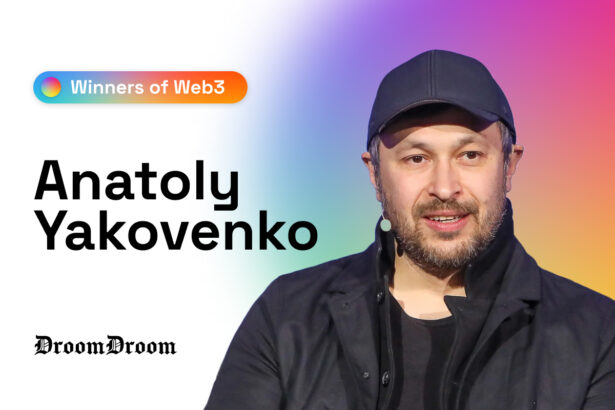It was one of those late nights where time blurs, and the world outside is no longer relevant. Two cups of coffee, one beer, and Anatoly Yakovenko—slumped over his computer in a dimly lit room—was sleepless but wired.
Somewhere between the haze of caffeine and exhaustion, an idea struck him, the kind of “lightbulb” moment that shifts entire industries. Yakovenko had stumbled onto what would become one of the most innovative solutions in blockchain technology: Proof of History. That night, without knowing it, he laid the foundation for Solana—one of the fastest programmable blockchains in the world.
The Boy From Moscow Who Saw the Future
Born in Moscow in the late 1970s, Yakovenko’s early years weren’t defined by what one might call luxury. He grew up obsessed with computers, coding at just five years old, his curiosity sparked in the waning years of the Soviet Union. In the early 1990s, his family relocated to the U.S., a world where he could feed that hunger for technology.
“I was that kid,” Yakovenko later said, half-laughing in self-deprecation, “who messed around with Linux and tried to break the internet.”
Like many great minds before him, he didn’t seem concerned about fitting in, famously sarcastic about how “popular” he was in high school.
Yet, it’s those kids tinkering with the open-source software while others are chasing social accolades who often change the world. A dream of writing code that could “solve some incredible problem for the world” drove him forward, inspired by the wave of the dot-com boom.
From Qualcomm to Solana: The Leap
Yakovenko wasn’t an overnight success. He navigated through the collapse of the dot-com bubble, stuck to computer science despite advice to abandon ship, and eventually found himself at Qualcomm. There, for nearly 13 years, he worked on distributed systems, and earned a reputation as the “systems engineer through and through,” as described by Andreessen Horowitz’s Ali Yahya.
In 2017, while developing deep-learning hardware with a friend, Yakovenko ventured into the world of crypto mining. This side project reignited his fascination with blockchain.
But it was that one sleepless night when he realized that the passage of time itself could be used as a structure for ordering events in a decentralized network. In other words, time was the answer to the problem of scalability.
And thus, Proof of History was born, a mechanism that allowed Solana to soar past other blockchains in transaction speeds—capable of 50,000 transactions per second (TPS), a feat unthinkable in Bitcoin or Ethereum’s ecosystems.
The Rise of Solana: Faster Than the Speed of Blockchain
Solana emerged from the shadow of Ethereum, offering the kind of speed and scalability Ethereum users could only dream of at the time.
While Ethereum struggled with the transition to ETH 2.0, bogged down by high gas fees and slow transaction times, Solana burst into the scene like the upstart that disrupts the establishment.
By 2021, Solana’s native token, SOL, had skyrocketed in value by over 6,500%, catching the attention of developers, traders, and venture capitalists alike.
Yakovenko’s mantra was simple: blockchain should be fast, scalable, and cheap—without sacrificing decentralization. Solana’s innovations, especially with Proof of History, allowed validators to process transactions in any order, reducing network congestion to near zero.
While Ethereum blocks were taking 15 seconds to form, Solana was doing it in 400 milliseconds. The comparisons to Visa or Nasdaq in terms of speed became more than just buzzwords; they were facts.
The Man Behind the Code: More Than Just a Visionary
But Anatoly Yakovenko is more than the sum of his technological achievements. His dedication spills into other parts of his life—an Ironman athlete, an underwater hockey player, a coder who unwinds by biking or surfing.
His work ethic is legendary, sometimes to the point of hilarity. “He came over to talk to us,” recalls co-founder Raj Gokal, “and without looking, he just stuck his hand in a bag of dog treats and started eating.” Yakovenko, so lost in thought, didn’t even notice until the entire team burst out laughing.
For all his quirky genius, he is also refreshingly unpretentious. At one of Solana’s famed Hacker House events in Miami, where 20-something developers with shaggy haircodes the next killer app, Yakovenko blended right in. Dressed in a gray sweatshirt, shorts, and sneakers, he looked more like another coder than the mastermind behind one of blockchain’s most disruptive projects.
The Price of Ambition
Solana’s meteoric rise wasn’t without its hiccups. A Distributed Denial-of-Service (DDoS) attack in 2021, during which the network attempted to process 400,000 transactions per second, caused the blockchain to falter.
While critics pounced on the vulnerability, Yakovenko spun it into a story of resilience, pointing out that despite the onslaught, the network never fully went down. “We let down a bunch of people,” he acknowledged, but he remained undeterred, continuing to lead Solana through new upgrades that would make the network even more robust.
The blockchain outages of 2022 raised concerns as well. Six different outages in one month, a 17-hour blackout, and a high-profile Wormhole hack leading to $320 million in lost crypto tested the resolve of both Yakovenko and the Solana community.
But for Yakovenko, these were growing pains—the kind of challenges a system faces when it scales exponentially. “Whenever you scale by a factor of 10, you get new engineering challenges,” he remarked. In his view, these setbacks were stepping stones toward something larger.
The Bigger Picture: Vision Beyond Blockchain
Despite the technical challenges, Yakovenko sees a future where blockchain is as commonplace as the internet, but he doesn’t just see humans using it. “Humans are not going to be the dominant thing that uses blockchains in the future,” he once said, hinting at a world where machines and automated systems utilize blockchain infrastructure in ways we haven’t yet imagined.
From finance to NFTs to decentralized organizations, Yakovenko believes Solana isn’t about competing with Ethereum or killing off competitors. It’s about becoming the underlying operating system for a decentralized world.
And his ambitions don’t stop there.
“Could 40 million people decide to buy every coal plant in the world and shut them down?” he mused in an interview.
His thoughts venture far beyond blockchain—they tap into the potential for collective, decentralized decision-making to solve real-world problems on a global scale.
The Legacy of a Disruptor
For Anatoly Yakovenko, the goal isn’t to kill Ethereum or even to dominate DeFi. Instead, it’s about pushing the boundaries of what’s possible. Solana’s mission, he insists, is about creating a platform where people—whether developers, machines, or organizations—can do whatever they want, at unprecedented speeds, and with negligible costs.
He is, as Jump Crypto President Kanav Kariya said, “a man chasing a dream. And he really just wants to create something cool and awesome and maybe, change the world a little bit.”
For now, Solana remains one of the fastest-growing ecosystems in Web3, a playground for developers, a hotbed for NFT creators, and a potential cornerstone of decentralized finance. And as for Yakovenko, the kid from Moscow who once messed around with Linux? He’s already written himself into the code of blockchain history—fast, scalable, and relentless.



















